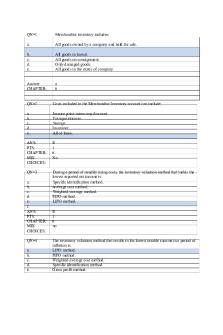Module 6 Activity 1 Other Patterns PDF

| Title | Module 6 Activity 1 Other Patterns |
|---|---|
| Author | Heather H |
| Course | General Biology |
| Institution | Metropolitan Community College, Nebraska |
| Pages | 3 |
| File Size | 75.8 KB |
| File Type | |
| Total Downloads | 51 |
| Total Views | 150 |
Summary
finding patterns ...
Description
Genetics Problems: Other Patterns These problems involve incomplete dominance and multiple alleles. 1. Two cats with medium-length tails have a litter which includes 6 with medium tails, 2 with long tails, and 3 with no tails. From these data, we might infer that incomplete dominance is operating here. Explain why this seems to be true and identify the genotypes of all these cats. Because there is an intermediate in between the dominate and recessive gene. Genotypes Mother: Mm
Father: Mm
Long-tailed kittens: MM
Medium-tailed kittens: Mm No-tailed Kittens mm
2. Unlike pea flower color, color of snapdragon flowers is controlled by incomplete dominance. White-flowered and red-flowered snapdragons are homozygous, while pink flowered-snapdragons are heterozygous. A nursery wants to cell seeds that only produce one color of flower. Identify the parents they would need to cross to produce seeds that will only produce one color of flower. Parents to produce only white-flowered offspring: WW Parents to produce only red-flowered offspring: RR Parents to produce only pink-flowered offspring: RW 3. A man with type AB blood marries a women with type O blood. What is the expected ratio of blood types in their children? % type O: zero
% type A: 50
% type B:50 % type AB: zero
4. A man with type A blood marries a women with type B blood. They have a child with type O blood. What are the genotypes of the man and women? What % of their children will have type AB blood? Man’s Genotype: AO %AB children: 25
Women’s Genotype: BO
5. In radishes, red and white are the pure-breeding colors and long and round are the pure-breeding shapes, while the hybrids are purple and oval. The cross of a red oval with a purple oval will produce what proportion of each of the 9 possible phenotypes? Use the table below to draw a Punnett square to help with the problem. Red-Oval Parent Purple Oval Parent
LLR r
LlR R
LlRr
LLRr
LLrr
LlRr
Llrr
LlRR
LlRr
llRR
llRr
LlRr
Llrr
llRr
llrr
LLRR
Red-Long: 1 /16
Red-Oval: 2 /16
Red-Round: 1 /16
White-Long: 1 /16
White-Oval: 2 /16
White-Round: 1 /16
Purple-Long: 2 /16
Purple-Oval: 4 /16
Purple-Round: 2 /16...
Similar Free PDFs

Ready Module 4 Activity 1
- 3 Pages

Module 6-1 Quiz
- 4 Pages

Activity 1-6 - From histology
- 21 Pages

Culminating Activity Module 3
- 2 Pages

PSY222 Module Four Activity
- 3 Pages

Activity-1-1 - ACTIVITY
- 9 Pages

PSY222 Module Four Activity
- 4 Pages

PSY222 Module Four Activity
- 3 Pages
Popular Institutions
- Tinajero National High School - Annex
- Politeknik Caltex Riau
- Yokohama City University
- SGT University
- University of Al-Qadisiyah
- Divine Word College of Vigan
- Techniek College Rotterdam
- Universidade de Santiago
- Universiti Teknologi MARA Cawangan Johor Kampus Pasir Gudang
- Poltekkes Kemenkes Yogyakarta
- Baguio City National High School
- Colegio san marcos
- preparatoria uno
- Centro de Bachillerato Tecnológico Industrial y de Servicios No. 107
- Dalian Maritime University
- Quang Trung Secondary School
- Colegio Tecnológico en Informática
- Corporación Regional de Educación Superior
- Grupo CEDVA
- Dar Al Uloom University
- Centro de Estudios Preuniversitarios de la Universidad Nacional de Ingeniería
- 上智大学
- Aakash International School, Nuna Majara
- San Felipe Neri Catholic School
- Kang Chiao International School - New Taipei City
- Misamis Occidental National High School
- Institución Educativa Escuela Normal Juan Ladrilleros
- Kolehiyo ng Pantukan
- Batanes State College
- Instituto Continental
- Sekolah Menengah Kejuruan Kesehatan Kaltara (Tarakan)
- Colegio de La Inmaculada Concepcion - Cebu







